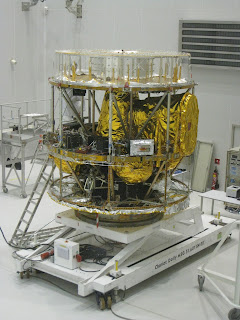To be precise, S5C is divided in 2 areas, North and South, to support two launch campaigns in parallel. This proves to be very useful for dual launch as it it the case for our ArianeV207 flight (launch of MSG-3 and EchoStar spacecrafts). MSG is accommodated in the North part, while EchoStar, a US telecom satellite, will be in the South part when it will arrive by my mid May at the EPCU.
Credits Arianespace/CNES/ESA: An overall view of the CSG EPCU facilities
After having arranged all the offices (furniture, Internet connections...), and even the coffee corner, we are now fully operational. Working days start at 7:00 am for most of us and end at around 18:00.We hold since two weeks our daily meeting at 9:00 am with all parties: EUMETSAT, ESA, Thales and our CSG colleagues. Below is a picture of our today's daily. (we could not took it earlier before the MSG-3 flag was properly installed :-)
These are in facts long days but all teams are very motivated, cooperative and working hard.
To be complete, we should not forget that there is a new comer in the team:
This is the MSG-3 mascot. A contest has been open to find him/her a nickname.
Toco, Shumi are already taken, any other ideas?













